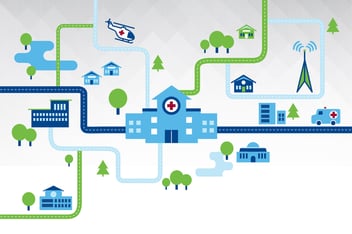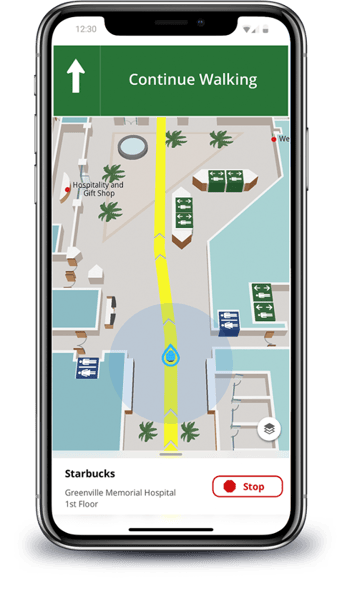We’re continuing our series on digital wayfinding in healthcare and hospitals. If you remember, our last post was Fun but Flawed Indoor Positioning Tech for Healthcare, and we looked at a variety of technologies with the promise of more to come. And here it is!
So, let’s return to science class and take a look at the electromagnetic (EM) spectrum. This is the range describing all different levels of EM radiation, aka light, in terms of wavelength and frequency. These two properties are inversely proportional. Frequency is measured by how long it takes for a wave to pass a fixed point. So, the longer the wavelength the longer this takes and the lower the frequency.
Colloquially, we think of light as something we can see with our eyeballs, or visible light. This is typically depicted as the mid-range of the EM spectrum. With higher frequencies you’ll find the uncomfortably intense UV rays and Gamma rays. On the lower end, with the big wavelengths, you get your radio waves. While higher frequencies carry more energy, the long, languid waves of radio frequency (RF) have their own special appeal:
- Wide wavelength signals are able to diffract around obstacles and pass through nonconductive materials like walls instead of being absorbed or bouncing off to who knows where. Don’t worry, tin foil hats are still an effective means to hinder radio-based mind control methods.
- Radio waves, peaceful creatures, play nicely with each other. This lessens the worry of interference even in areas thick with signal, which is one reason why radio is good for broadcast technology.
- The relatively low energy needed for radio is also a boon, allowing for solutions which are less resource intensive than higher frequency options.
- High energy electromagnetic waves can also have a rather disastrous effect on the human body, which we can all agree is best avoided. Gone are the days of shoe-fitting fluoroscopes and other unfortunate forays of consumer technology into the danger zone of the EM spectrum. Radio waves are super safe, which is a very good thing.
These strengths have made RF desirable for long range communication and the transmission of information. With this well deserved popularity has come the need for considerate organization of which ranges, often called bands or portions, are reserved for what. Think of tuning into an AM or FM radio station. The reason you’re able to clearly hear that Kars 4 Kids commercial for the 20th time is that no other signal is broadcasting on that frequency. Similarly, wireless radio technologies can be thought of in terms of the bands in which they operate, and the protocols which define how the signals are structured to facilitate the transfer of data.
You’ll see many familiar faces in the upper range of radio, many living in the Ultra High Frequency, or UHF, band. Here you’ll find GPS and Bluetooth, as well as broadcast technology and some bands used for cellular networks and Wi-Fi. Now that we understand the EM spectrum, next time we’ll take a closer look at Bluetooth and the good reasons why it’s a popular choice for indoor hospital wayfinding technology.

